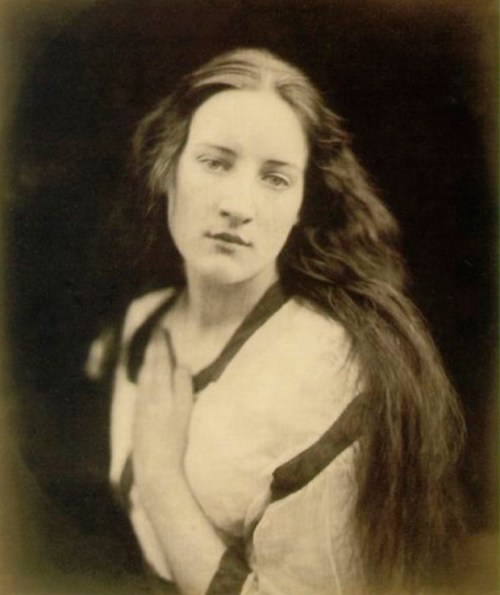Julia Margaret Cameron: Victorian Photographer in Ceylon

Source:Thuppahis
Benita Stambler, an original essay for Thuppahi, but also pointing to a Special Exhibition in London on Julia Margaret Cameron
Julia Margaret Cameron was one of the stars of nineteenth century British photography. Her luminescent work remains popular for museum exhibitions even today. What is not commonly known about her, however, is that she was among the earliest portrait photographers in Ceylon. Her photographs taken while she lived in Ceylon stand apart from the vast output of photographs she took in Britain.
 Untitled, 1875-1879, The Art Institute of Chicago, https://commons.wikimedia.org/wiki/File:Untitled_(Ceylon)_2,_by_Julia_Margaret_Cameron.jpg
Untitled, 1875-1879, The Art Institute of Chicago, https://commons.wikimedia.org/wiki/File:Untitled_(Ceylon)_2,_by_Julia_Margaret_Cameron.jpg
Julia Margaret Cameron (1815-1879) was unique among Victorian-era British photographers in many ways. First of all, she was a woman. Women were rare in most professions at the time, and photography was no exception. Second, she created portraits of some of the most notable people of Victorian England, such as Alfred Lord Tennyson and Charles Darwin, at a time when commercial photographers who were practicing their craft often toiled in obscurity. Third, she developed her own unique soft-focus style, while a major trend in photography was to strive for accuracy in capturing the real world or, at the very least, a “composed” real world. Finally, unlike almost all her contemporaries in Britain, she created a limited series of photographs taken in Sri Lanka, known as Ceylon at that time.
The Cameron name was important in Ceylon in its day because of the reform ideas of the Colebrooke-Cameron Commission, named for Julia Margaret’s husband, Charles Hay Cameron. Charles was fascinated by the island’s landscape, inspiring him to buy land for plantations. Julia Margaret was born in India, educated in France, returned to India, then lived much of her life in England. Finally, in 1875, near the end of their lives, the Camerons moved to the properties they owned in Ceylon. Even in their relatively impecunious situation by British standards, they employed local people to work on their estates and plantations. It is these persons who were often called upon as subjects of the Cameron photographs taken in Ceylon, with a few exceptions. Julia Margaret Cameron died in 1879, providing only a brief window of opportunity to record portraits of island inhabitants in her own inimitable style.
In some of her British photographs people were posed in scenes that made allusions to historical, literary, or biblical stories. Her photographs in Ceylon, although retaining her atmospheric style, seem to be much less artificial.
 Untitled, 1875-1879,J. Paul Getty Museum, https://commons.wikimedia.org/wiki/File:Untitled_(Ceylon)_3,_by_Julia_Margaret_Cameron.jpg
Untitled, 1875-1879,J. Paul Getty Museum, https://commons.wikimedia.org/wiki/File:Untitled_(Ceylon)_3,_by_Julia_Margaret_Cameron.jpg
While her photographs taken over a period of about ten years in Britain were often for commercial and artistic purposes, those of Ceylon seem to be of a more personal nature. Certainly, at the time, there was a substantial market for portraits of the people of Ceylon for the colonial visitor. Firms such as Skeen & Co. and Scowen & Co. were beginning their successful businesses, creating photographs that emphasized the tropical paradise of Ceylon and the distinctive clothing and appearance of the people who inhabited the island. Julia Margaret Cameron could have participated in this market, if that had been her purpose. And, yet, there are fewer than thirty photographs extant that she took while in Ceylon.
Some have considered her use of local people as photographic models in terms of taking advantage of the “hired help” and posing them to emphasize their sexualized and exploited characteristics. Others have seen these sitters as subjects of convenience, making do with the most accessible models without adding pretense. When her friend, the painter Marianne North, came to visit in Ceylon, Cameron dressed her in an uncomfortable and unseasonal outfit in order to capture North on film. Her photographs of local residents, in contrast, while certainly subject to some staging and without personal identification, provide a much more naturalistic impression, while still conveying their exotic characteristics through hairstyles, features, dress and jewelry.
 Young Ceylonese Woman Plantation Worker, 1875-1878, Julia Margaret Cameron © National Media Museum, Bradford / Science & Society Picture Library
Young Ceylonese Woman Plantation Worker, 1875-1878, Julia Margaret Cameron © National Media Museum, Bradford / Science & Society Picture Library
The small number of photographs that remains as the legacy of Julia Margaret Cameron in Ceylon almost serves as a footnote to the development of her personal photographic style. They exhibit the same attention to the balancing of light and dark, but some reviewers suggest that her Ceylon photos convey a lack of pretension, a greater sense of focus and less artificiality than some of her British photographs, particularly those of staged scenes that imitated paintings. This dichotomy raises questions to be considered by anyone who views her photographs.
The clarity of Julia Margaret Cameron’s photographs in Ceylon is not so much a function of their physical sharpness, but rather of the impression of a glimpse into the character of the sitter that they convey. Her work stands as a testament to ongoing conversations, then and now, of the artistic purpose of the medium of photography and ideas of naturalism and creativity. For those who wish greater “exposure” to her work, an exhibition of more than 100 of Julia Margaret Cameron’s photographs will be held at the Victoria and Albert Museum in London from November 28, 2015 through February 21, 2016.







